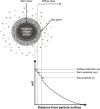Physicochemical characterization of drug nanocarriers
- PMID: 28761340
- PMCID: PMC5516877
- DOI: 10.2147/IJN.S133832
Physicochemical characterization of drug nanocarriers
Abstract
Pharmaceutical design has enabled important advances in the prevention, treatment, and diagnosis of diseases. The use of nanotechnology to optimize the delivery of drugs and diagnostic molecules is increasingly receiving attention due to the enhanced efficiency provided by these systems. Understanding the structures of nanocarriers is crucial in elucidating their physical and chemical properties, which greatly influence their behavior in the body at both the molecular and systemic levels. This review was conducted to describe the principles and characteristics of techniques commonly used to elucidate the structures of nanocarriers, with consideration of their size, morphology, surface charge, porosity, crystalline arrangement, and phase. These techniques include X-ray diffraction, small-angle X-ray scattering, dynamic light scattering, zeta potential, polarized light microscopy, transmission electron microscopy, scanning electron microcopy, and porosimetry. Moreover, we describe some of the commonly used nanocarriers (liquid crystals, metal-organic frameworks, silica nanospheres, liposomes, solid lipid nanoparticles, and micelles) and the main aspects of their structures.
Keywords: controlled drug release; drug delivery; nanoparticles; physicochemical properties.
Conflict of interest statement
Disclosure The authors report no conflicts of interest in this work.
Figures










Similar articles
-
Stable Discoidal Bicelles: A Platform of Lipid Nanocarriers for Cellular Delivery.Methods Mol Biol. 2017;1522:273-282. doi: 10.1007/978-1-4939-6591-5_22. Methods Mol Biol. 2017. PMID: 27837547
-
Identification of large channels in cationic PEGylated cubosome nanoparticles by synchrotron radiation SAXS and Cryo-TEM imaging.Soft Matter. 2015 May 14;11(18):3686-92. doi: 10.1039/c5sm00169b. Soft Matter. 2015. PMID: 25820228
-
Cubic lyotropic liquid crystals as drug delivery carriers: Physicochemical and morphological studies.Int J Pharm. 2018 Oct 25;550(1-2):57-70. doi: 10.1016/j.ijpharm.2018.08.003. Epub 2018 Aug 17. Int J Pharm. 2018. PMID: 30121331
-
In vitro and in vivo characterization of pharmaceutical nanocarriers used for drug delivery.Artif Cells Nanomed Biotechnol. 2019 Dec;47(1):524-539. doi: 10.1080/21691401.2018.1561457. Artif Cells Nanomed Biotechnol. 2019. PMID: 30784319 Review.
-
Physicochemical characterization of colloidal drug delivery systems such as reverse micelles, vesicles, liquid crystals and nanoparticles for topical administration.Eur J Pharm Biopharm. 2004 Sep;58(2):343-56. doi: 10.1016/j.ejpb.2004.03.028. Eur J Pharm Biopharm. 2004. PMID: 15296960 Review.
Cited by
-
Curcumin clarithromycin nano-form a promising agent to fight Helicobacter pylori infections.World J Microbiol Biotechnol. 2023 Sep 29;39(12):324. doi: 10.1007/s11274-023-03745-7. World J Microbiol Biotechnol. 2023. PMID: 37773301 Free PMC article.
-
Development and Evaluation of a Reconstitutable Dry Suspension Containing Isoniazid for Flexible Pediatric Dosing.Pharmaceutics. 2020 Mar 23;12(3):286. doi: 10.3390/pharmaceutics12030286. Pharmaceutics. 2020. PMID: 32210125 Free PMC article.
-
Lipid-Based Antimicrobial Delivery-Systems for the Treatment of Bacterial Infections.Front Chem. 2020 Jan 10;7:872. doi: 10.3389/fchem.2019.00872. eCollection 2019. Front Chem. 2020. PMID: 31998680 Free PMC article. Review.
-
Characterization Methods for Nanoparticle-Skin Interactions: An Overview.Life (Basel). 2024 May 8;14(5):599. doi: 10.3390/life14050599. Life (Basel). 2024. PMID: 38792620 Free PMC article. Review.
-
Chitosan-Clay Mineral Nanocomposites with Antibacterial Activity for Biomedical Application: Advantages and Future Perspectives.Int J Mol Sci. 2024 Sep 26;25(19):10377. doi: 10.3390/ijms251910377. Int J Mol Sci. 2024. PMID: 39408707 Free PMC article. Review.
References
-
- Petros RA, DeSimone JM. Strategies in the design of nanoparticles for therapeutic applications. Nat Rev Drug Discov. 2010;9(8):615–627. - PubMed
-
- Aznar E, Marcos MD, Martínez-Máñez R, et al. pH- and photo-switched release of guest molecules from mesoporous silica supports. J Am Chem Soc. 2009;131(19):6833–6843. - PubMed
-
- Dong YD, Boyd BJ. Applications of X-ray scattering in pharmaceutical science. Int J Pharm. 2011;417(1–2):101–111. - PubMed
-
- Chang JH, Shim CH, Kim BJ, Shin Y, Exarhos GJ, Kim KJ. Bicontinuous, thermoresponsive, L3-phase silica nanocomposites and their smart drug-delivery applications. Adv Mater. 2005;17(5):634–637.
Publication types
MeSH terms
Substances
LinkOut - more resources
Full Text Sources
Other Literature Sources

